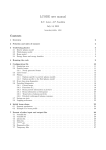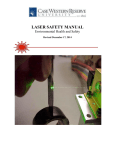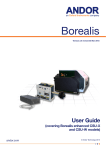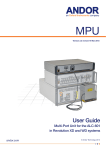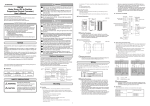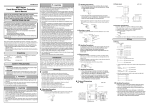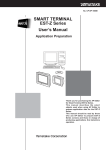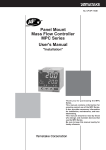Download laser tec
Transcript
TECHNICAL GUIDE FOR LASER SENSORS Laser is an acronym from "Light Amplification by Stimulated Emission of Radiation." A laser is a device which radiates coherent light by excitation of electrons in a gas or a solid to a high energy state, and release of this energy in the form of light after amplification by back and forth oscillations Laser beam wavelength Semiconductor laser Liquid laser Type of laser Solid laser Band EHF Wavelength 10mm FIR, MIR,NIR 1mm 100m 10m Visible Gas laser A laser beam has the following features: 1. Monochromatic 2. Low divergence 3. High energy density 4. Coherent in phase UV, EUV, soft X-ray 1m 100nm 10nm 1nm Types of lasers Examples of materials which are used to emit laser beams are: Liquid: Pigment Gas: He-Ne, Ar and CO2 Solid: YAG, ruby and glass Semiconductor: GaAs Even a small laser beam has such a high energy density that it may be Products) was established based on IEC standards. (The U.S. FDA harmful to the human skin or eyes. To prevent injuries by laser standard also uses a similar classification system for laser products.) products, JIS C 6802-1997 (Radiation Safety Standards for Laser • JIS C 6802-1997 classification Class Yamatake model Degree of danger Class 1 PBZ series • Intrinsically safe design Class 2 HLA series • Visible wavelength and low power • Eyes react instinctively to laser beam and protect themselves. Class 3A • Dangerous if eyes are exposed to laser beam through an optical instrument. • In case of visible wavelength, eyes react instinctively to laser beam and protect themselves. Class 3B • Looking directly into the laser beam under any circumstances is dangerous. Class 4 • Very intense. • Even diffuse reflection is possibly dangerous. • Can burn skin or cause a fire. Notice No. 39 by the Ministry of Health, Labour and Welfare in Japan defines safeguards for workers in “Measures for the Prevention of Injury by Laser Beam” for laser products of Class 3A or over. For details, refer to that notice. 1 Safety precautions required for users of laser products in each laser product class are stated in JIS C 6802 and IEC 60825-1. • The following table is only a summary for the sake of convenience. Refer to the original standard for complete requirements. Class Requirement/Item Class 1 Class 2 Class 3A*2 Class 3B Class 4 Remote interlock connector Not required Connected to room or door circuit. Control by means of a key Not required Key is removed when laser is not in use. Beam attenuator Not required Prevents accidental exposure during use. Laser emission indicator Not required ON during laser emission. Warning sign Not required Gives warning instructions. Beam path Specular reflections No requirement Terminates within the intended range. No requirement Prevention of accidental reflection. Eye protection Not required Required where technical or administrative measures cannot be taken, and where the exposure exceeds the MPE (maximum permissible exposure). Protective clothing Not required Required depending Specific instructions on the conditions. are required. Training Training is necessary for all operators and maintenance personnel. Not required Notes: *1. Source: JIS C 6802-1997, Radiation Safety Standards for Laser Products, Appendix, Table D3. *2. With regard to remote interlock connector, key control, laser emission indicator and eye protection, within the 400 to 700 nm wavelength range, Class 3B laser products whose emission does not exceed 5 times the Class 2 AEL are regarded as Class 3A laser products. 2 FDA CLASSIFICATION FDA (CDRH) The Food and Drug Administration (FDA) is a U.S. governmental agency that oversees many smaller organizations. One of these organizations is the Center for Devices and Radiological Health (CDRH), which is responsible for radiological electrical products and medical devices. Products using lasers are controlled by the CDRH. 21 CFR Part 1040.10 provides specific safety standards for laser products. Products that do not comply with these standards cannot be sold in the U.S., nor can they be imported to the U.S. Therefore, manufacturers of laser products are required to file a Product Report with the CDRH demonstrating conformity to Part 1040.10 before selling laser products in or importing laser products to the United States. FDA 21 CFR Part 1040.10 (CDRH) FDA laser product classification Class Laser class valuation Class I Levels of laser radiation are not considered to be hazardous. Class IIa Lasers emit radiation in the visible wavelength range of 400 to 710 nm. Levels of laser radiation are not considered to be hazardous if viewed for 1000 s or less, but are considered to be a chronic viewing hazard for more than 1000 s. Class II Lasers emit radiation in the visible wavelength range of 400 to 710 nm. Levels of laser radiation are considered to be a chronic viewing hazard. Eye protection is normally afforded by aversion responses, including the blink reflex. Class IIIa Levels of laser radiation are considered to be, depending on the irradiance, either an acute intrabeam viewing hazard or chronic viewing hazard. Levels of laser radiation are considered to be an acute viewing hazard if viewed directly with optical instruments. Class IIIb Levels of laser radiation are considered to be an acute hazard to the skin and eyes from direct radiation. Class IV Levels of laser radiation are considered to be an acute hazard to the skin and eyes from direct and diffuse radiation. FDA performance requirements according to laser classifications ○: Required △: Required depending on the conditions – : Not applicable Class I IIa II IIIa IIIb IV Protective housing ○ ○ ○ ○ ○ ○ Safety interlock*1 △ △ △ △ △ △ Remote interlock connector – – – – ○ ○ Key control – – – – ○ ○ Location of control – ○ ○ ○ ○ ○ Laser radiation emission indicator – – ○ ○ ○ ○ Beam attenuator – – ○ ○ ○ ○ Scanning safeguard*2 △ △ △ △ △ △ Manual reset mechanism – – – – – ○ Identification label ○ ○ ○ ○ ○ ○ Certification label ○ ○ ○ ○ ○ ○ Warning label – – ○ ○ ○ ○ Aperture label – – ○ ○ ○ ○ Protective housing label*3 △ △ △ △ △ △ *1. A safety interlock is not necessary if the protective housing cannot be detached or moved. *2. The scanning safeguard is required regardless of class if the product incorporates a laser scanning system. *3. A label is required on every portion of the protective housing that can be removed or displaced if a laser greater than Class I can be emitted when the portion is moved. 3 GLOSSARY Resolution Linearity Even when detecting a stationary target, analog output voltage fluctuates slightly due to internal noise. The amount of fluctuation is called resolution; the smaller the fluctuation, the better or higher, the resolution. Example: ±0.1 % FS The minimum readable measurement is 1/1000 of the measurement range. In digital signal processing, the resolution refers to the minimum reading of the measurement, or the minimum indication unit. Analog voltage output from a displacement sensor increases in proportion to the distance. The relationship of analog output voltage to distance is ideally represented by a straight line. However, actual measurements deviate from this line. Linearity is the tolerance range in relation to the ideal line, and is indicated as a percentage of full scale. Measurements obtained by digital signal processing are slightly different from actual displacement. In this case, linearity refers to the ratio of this difference to the measurement range. Linearity Voltage Actual measurement Voltage Resolution Ideal line Distance Distance Temperature characteristics The analog output voltage changes with ambient temperature. Temperature characteristics refers to the change in the level of ° Example: ±0.1 % FS/°C (FS = 1 V) PRECAUTIONS FOR USE • A label like that shown is affixed to laser products. Follow the instructions on the label. • Do not stare into the laser beam. Avoid specular reflection radiation entering the eyes. Never point a laser beam towards someone's eye. • Shield the laser beam to prevent radiation from reaching the human body. • For safety, terminate the beam path by a diffusing or absorbing object with appropriate reflectivity and thermal characteristics. HLA label • If the warning label on the installed sensor is not visible, affix the included warning label on a visible part of the sensor before use. Refer also to user’s manual and specifications for your model. 4




